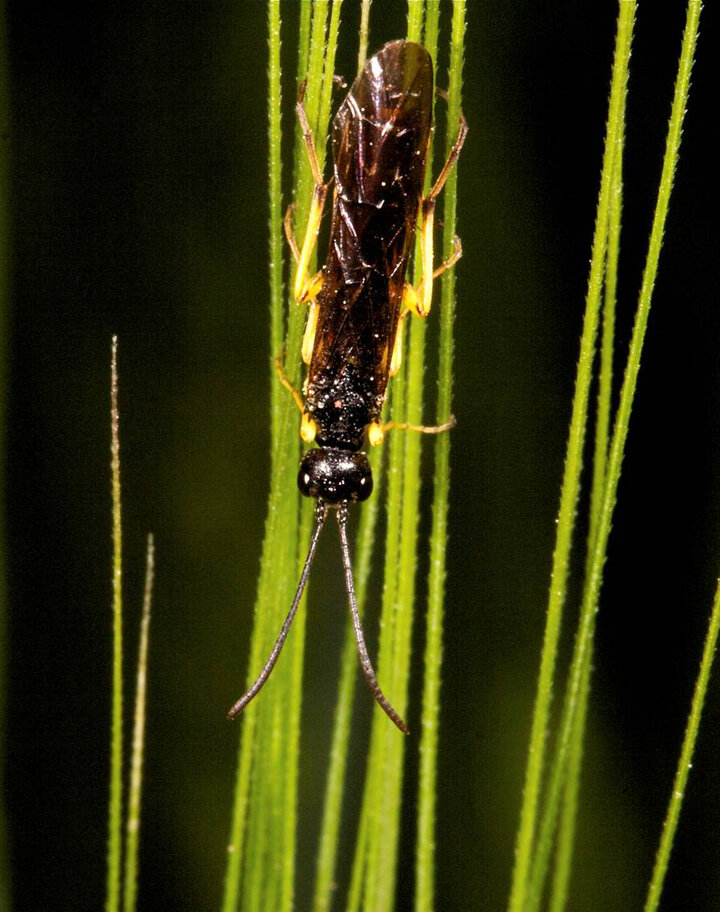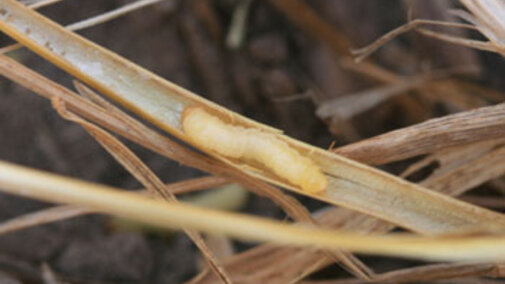Sawfly management in wheat can be difficult as there is no single solution. Management must be a diversified approach using a number of tools. First, understanding the biology of wheat stem sawfly (Figure 1) and that they emerge from the previous year’s wheat stubble is helpful. Adequately scouting wheat fields and knowing which fields have greater levels of infestation can help manage the effects of sawfly this year as well as next year.
If high levels of sawfly are observed in some wheat fields and not others, harvest of the highly infested fields should be prioritized first, when possible. Often, wheat may be infested with sawfly (Figure 2) but will remain standing until wind or rain cause it to lodge. Severely infested fields should be harvested as soon as possible to prevent yield loss due to the inability of combines to pick up the wheat from the ground.
Management
Knowing which fields have sawfly issues gives the grower a head start the following year in knowing where to manage or watch for sawfly. Although management strategies are limited, a few options are available that may reduce the impact of sawfly.
One option is to increase the distance between wheat fields from one year to the next. Often, wheat fields are most infested with sawfly when grown adjacent to wheat residue that was infested with sawfly the year prior.
Another option is to use tillage to bury the residue. Tillage is most beneficial when completed prior to sawfly emergence in May. Because burying the residue is important, plowing or discing would be recommended over using sweeps or other forms of limited tillage which tend to leave more residue on the soil surface.
Wheat variety selection has proven to be effective at mitigating the impact of wheat stem sawfly. Solid stem wheat is the best choice. Sawfly can still successfully complete its life cycle in solid stem wheat, but significantly fewer are able to survive and only rarely does solid stem wheat lodge.


The negative aspect of solid stem wheat is yield. The best options are wheat varieties developed out of Montana; however, they are not well adapted to our area. Warhorse has traditionally performed the best of the solid stem wheat evaluated. However, it will mature later than Nebraska-adapted wheat and yield will be significantly lower. In one experiment in 2017, Warhorse yielded 42 bushels per acre while Chrome and Pronghorn both yielded 63 bushels per acre. Both Chrome and Pronghorn were highly infested with sawfly but were harvested prior to lodging.
Another option would be to select a hollow-stemmed wheat that is relatively short and less likely to lodge in wind events. This option hasn’t been fully explored or so it is unknown how this approach will help to alleviate the effects of sawfly.
Finally, planting date could provide some relief. Wheat planted early or late may be able to avoid the ideal time for sawflies to infest and cause damage. This has only been observed at this time and has not been quantified.
Scouting and being aware are the first steps to managing sawfly. Once an understanding of the location and density of sawfly is known, multiple cultural practices should be used to successfully manage it.
Also see:

